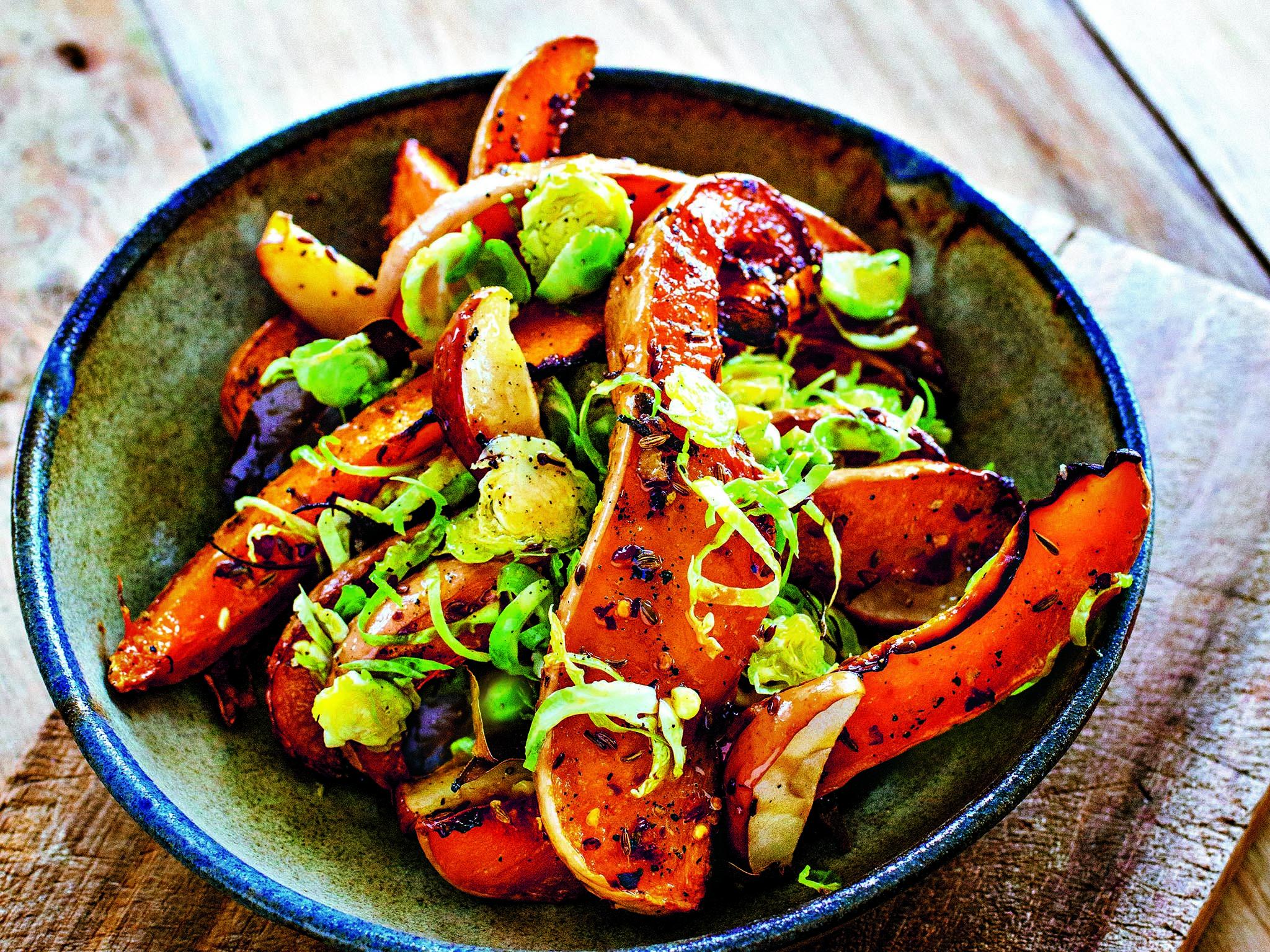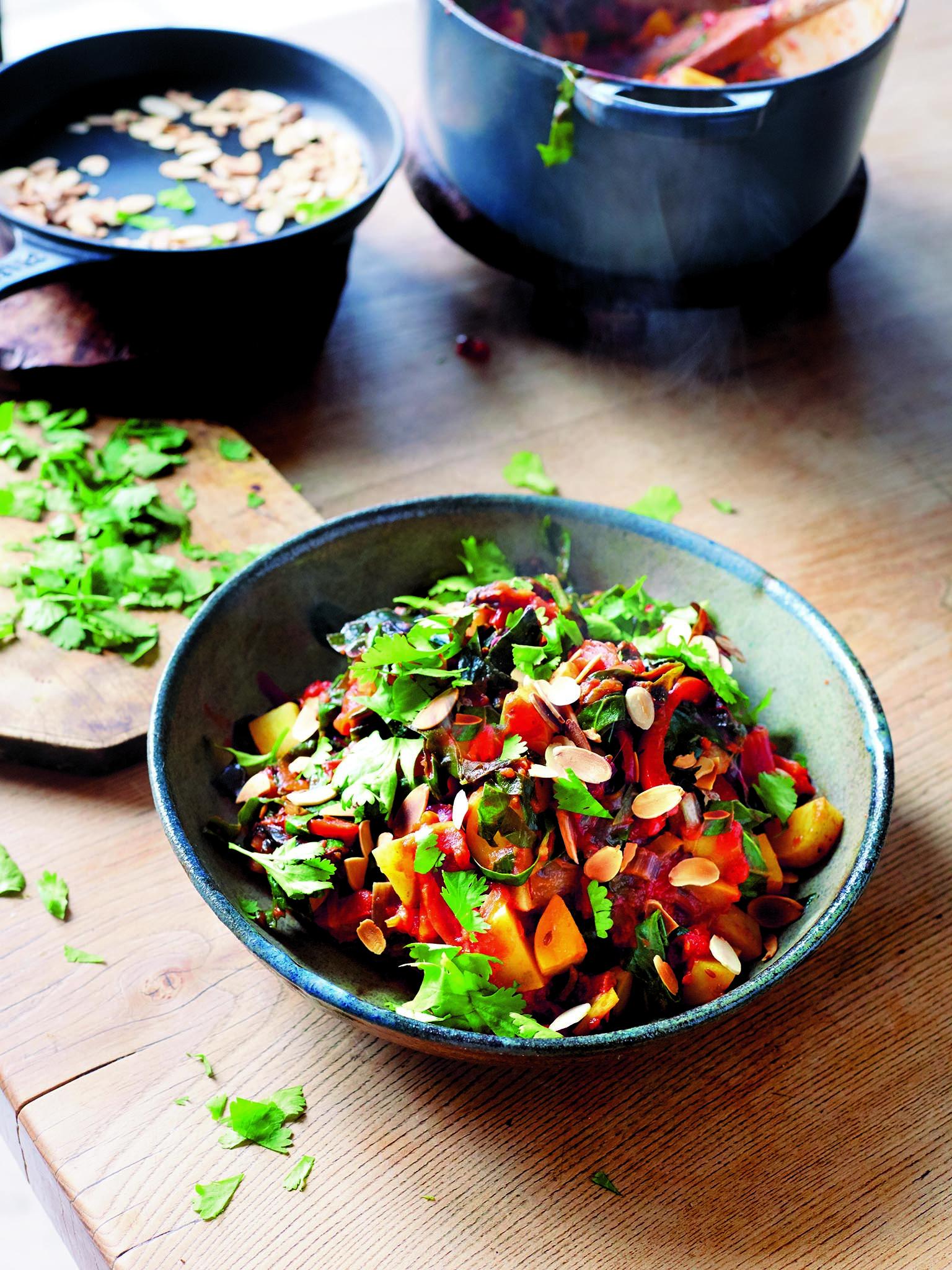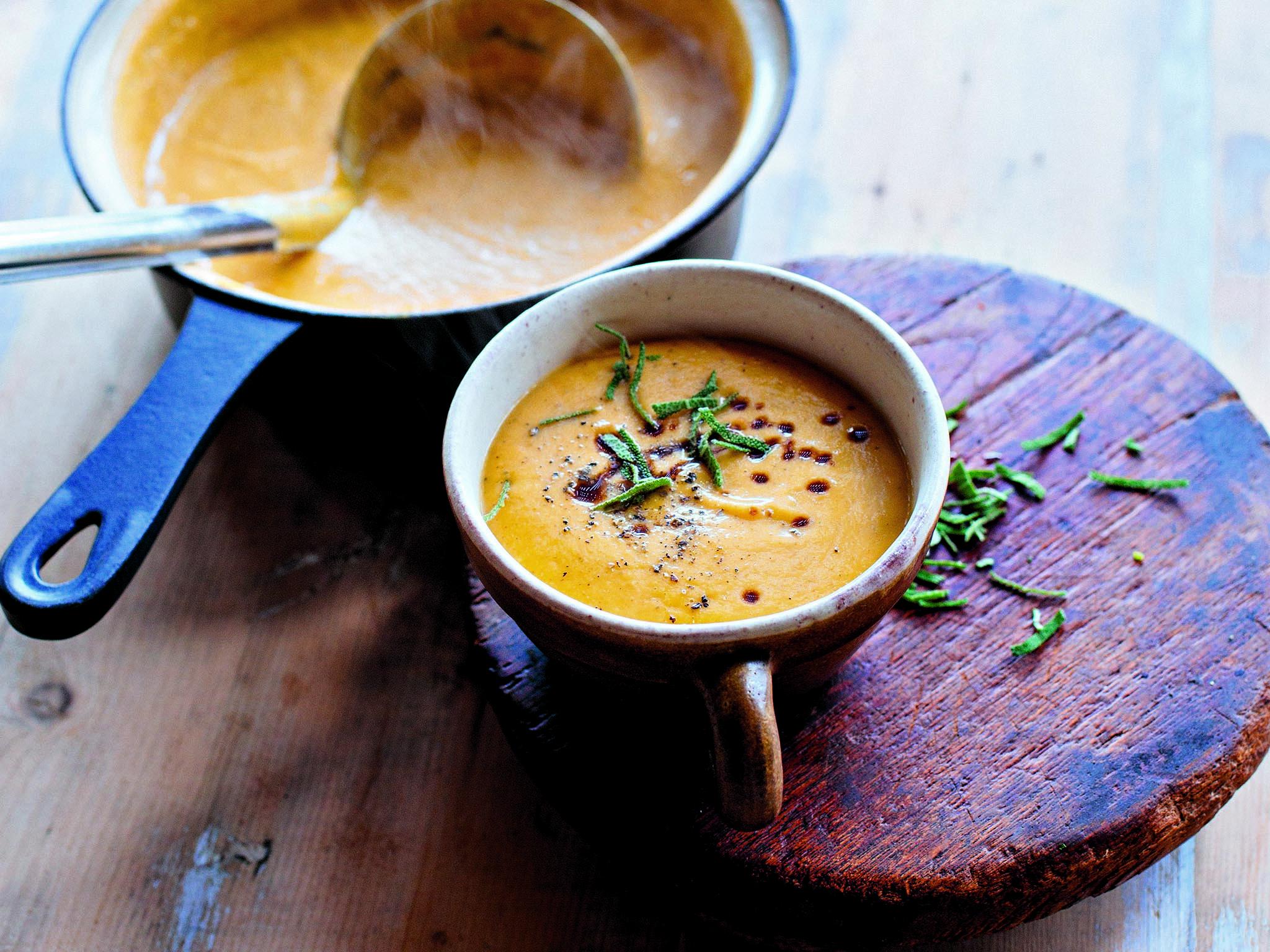How Hugh Fearnley-Whittingstall is getting us to eat much more veg
River Cottage chef Hugh Fearnley-Whittingstall's new book does exactly what it says on the tin – makes vegetables delicious so we eat much more of them

More veg is good for the planet too: Simple and inexpensive to produce, and vastly less demanding of energy and resources than animal-based foods. And if we eat more veg, we can also eat less meat and fish – or none at all, if we choose. As many of you know, I do eat both (discerningly, I hope, with the welfare of our farm animals, and the environment, in mind). But you’ll find none of either in these pages. I want this book to be wholly inclusive. And I think vegetables should be the most inclusive foods we eat – a bounty for all. I’ve been making a conscious effort for some years now to shift towards a veg-centric way of eating – and the recipes here are a testament to that exciting, satisfying culinary adventure.
I’m pretty sure most of us know that we should be consuming more vegetables (and fruits), so why aren’t we? Perhaps it’s because our culinary culture has not been particularly kind to veg. We’ve long eaten them, of course, but not often in the colourful, creative, respectful ways that other cuisines have come up with. There’s been too much boiling going on: So many of us grew up viewing vegetables as something plain on the side of the plate, hidden under the gravy. That’s no way to learn how exciting veg can be!
For much of my (semi-) professional cooking career, I also put veg mainly “on the side”, allowing well-chosen meat and fish to dominate my culinary thinking. I certainly wasn’t a veg-dodger. But I had my favourites – raw peas from the pod, simply buttered greens, roast parsnips, barbecued courgettes and spring onions – and I didn’t seek to ring the changes with any great conviction.
But as I began to grow more veg of my own at River Cottage, and dabble in a more worldly (often Asian-inspired) way with vegetables, I began to realise that I was hugely underestimating the power of veg to deliver pleasure as well as goodness to me and my family. That was when I decided that a stint as a vegetarian might do me – and my kitchen repertoire – some good. It was transformative. River Cottage Veg Every Day – the book and the TV series – was the result of that experiment. And in many ways this book is too.
Roast squash and apple with raw sprouts
This wonderful autumnal salad, from my ever-brilliant collaborator Gill Meller, is hot and tender, spicy and aromatic, crisp and raw – the range of textures and flavours is superbly satisfying. And it’s so easy to throw together.
Serves 3-4
about 1kg squash, such as a medium butternut or acorn squash, or ½ crown prince
2 tbsp olive or rapeseed oil
4-5 bay leaves, roughly torn
2 sprigs of rosemary, roughly torn
a small handful of sage leaves, roughly torn (optional)
1 tsp fennel seeds
a pinch of dried chilli flakes
about 175g brussels sprouts
2 medium eating apples
25g sunflower seeds (or other seeds of your choice)
sea salt and black pepper
For the dressing
2 tbsp extra virgin olive or rapeseed oil
2 tsp English mustard
1-2 tsp sugar
1 tbsp cider vinegar
Preheat the oven to 200°C/fan or 180°C/gas 6. Halve the squash and scoop out the seeds, but don’t remove the peel. Cut into slim wedges, about 2cm wide at the outside edge, and place in a large roasting tray. Trickle over the oil then scatter over the herbs, fennel seeds, chilli flakes and some salt and pepper. Turn the pieces of squash over in the oil and seasonings, then place in the oven and roast for about 30 minutes until tender and nicely browned in places.
Meanwhile, combine all the ingredients for the dressing in a large bowl, adding salt and pepper to taste. Trim the sprouts and remove any damaged or dirty outer leaves then slice very thinly. Add them to the bowl of dressing and mix well, breaking up the layers of sprout a bit as you go. Quarter the apples, remove the cores and cut each quarter into 2 or 3 wedges (again, no need to peel). Set aside.
When the squash is tender and starting to brown, add the apple wedges and stir them in with the squash and seasonings. Return to the oven for about 15 minutes or until the apples are tender but not broken down. Scatter the seeds over the veg and apple for the last few minutes of cooking, so they toast lightly. Spoon the dressed sprouts over the hot squash and apple wedges, then serve.
Swaps: Replace the squash with a combination of peeled and roughly chunked-up parsnips and carrots. Instead of greens, use finely shredded Savoy cabbage instead of the sprouts.

Pepper, potato and chard stew with saffron
This is based on the lovely chachouka in River Cottage Veg Every Day. There are no eggs this time, but even more veg, with potatoes and chard adding to the rich pepper and tomato base. I really like the earthy, pungent tang of saffron in the dish, but the stew is still delicious without it.
Serves 4
2 tbsp olive or rapeseed oil
1 tsp cumin seeds
1 large onion, quartered and thinly sliced
1 large (or 2 small) red pepper(s) (about 250g in total)
200g chard
500g new, waxy or salad potatoes, scrubbed
2 garlic cloves, finely grated or crushed
2 x 400g tin(s) of tomatoes
large pinch of saffron strands
½ tsp hot smoked paprika
1 tsp sugar
juice of ½ small lemon, or to taste
sea salt and black pepper
To finish
about 30g toasted flaked almonds
handful of coriander leaves
extra virgin olive or rapeseed oil
Place a large flameproof casserole or small stockpot over a medium heat and add the oil. When it’s hot, add the cumin seeds and let them sizzle for a minute or two. Add the onion with a pinch of salt, stir well, then cover and lower the heat. Let the onion sweat, stirring once or twice, for about 10 minutes.
In the meantime, quarter, deseed and thinly slice the peppers. Separate the chard stalks and leaves and cut both into 1cm thick slices. Cut the potatoes into bite-sized chunks. When the onion is nice and soft, stir in the garlic, then add the red pepper, chard stalks and potatoes. Replace the lid and cook gently for about 20 minutes until the pepper is softened, stirring now and again to ensure nothing sticks and burns.
Add the tomatoes with their juice, crushing them with your hands as you do so. Add the saffron, smoked paprika, sugar and some more salt and pepper and stir well. Simmer gently, uncovered, for about 15 minutes, until the potatoes are tender, stirring regularly. Toss in the chard leaves, cover the pan and cook for another 5 minutes, or until they have wilted. Stir the leaves into the stew. Take off the heat. Add the lemon juice then taste the stew and adjust as necessary, with more salt, pepper and/or lemon. Serve scattered with the toasted almonds and coriander and trickled with extra virgin oil.
Swaps: You can use spinach instead of chard – there’s no need to cook the stalks separately, just wilt the spinach in at the end of cooking. Finish the dish with mint or parsley rather than coriander.

Squash and cauliflower soup with sage
This is so easy to make: The veg are simply roasted then blitzed. It’s fantastic finished with a trickle of good, sweet balsamic vinegar.
Serves 6-8
1 small-medium cauliflower (about 700g)
about 600g squash, such as a small onion squash, or ½ large butternut or a chunk of Crown Prince
1 large onion, roughly chopped
4 garlic cloves, peeled but left whole
2 tbsp roughly chopped sage, plus a few finely ribboned leaves to finish
2 tbsp olive or rapeseed oil
1 litre hot veg stock
sea salt and black pepper
To finish
Balsamic vinegar
Flaky sea salt, to sprinkle
Preheat the oven to 200°C/Fan or 180°C/Gas 6. Remove any very damaged or tough-looking leaves from the outside of the cauliflower and trim the very end of the stalk. Then roughly chop the rest of the cauliflower – stem, leaves and all – and put into a large roasting tray.
Peel and deseed the squash then cut into bite-sized chunks. Add these to the roasting tray with the onion, whole garlic cloves and chopped sage. Trickle over the oil, season with salt and pepper and stir well. Roast for about 45 minutes until the vegetables are soft and nicely caramelised, stirring halfway through. Make sure there’s some good colour on the cauliflower especially – this adds to the flavour of the finished soup.
You now need to purée the soup with the hot veg stock. There’s a lot of veg here, so do this in two batches: Blitz half the veg with half the stock in a blender until smooth then pour into a large saucepan; repeat with the rest of the veg and stock. Once the two batches are reunited, you may want to add a touch of hot water to thin the soup a little. Taste and add more salt and pepper if needed, and reheat if necessary.
Ladle the soup into warmed bowls, splash some balsamic onto each serving then add a little finely ribboned sage, ground pepper and a few grains of flaky sea salt.
Extract taken from River Cottage Much More Veg by Hugh Fearnley-Whittingstall (Bloomsbury, £26), out now
Join our commenting forum
Join thought-provoking conversations, follow other Independent readers and see their replies
Comments
Bookmark popover
Removed from bookmarks